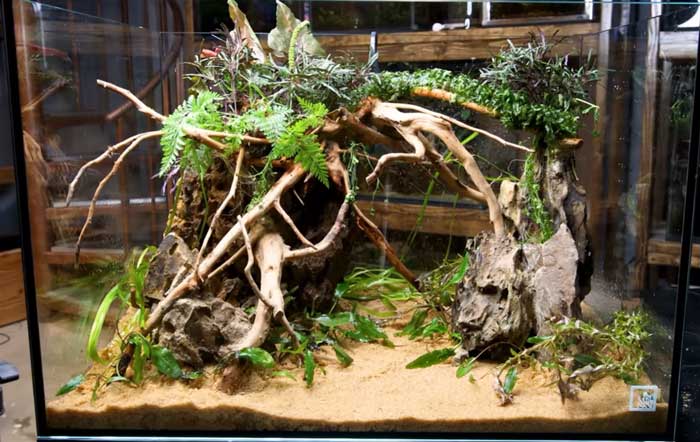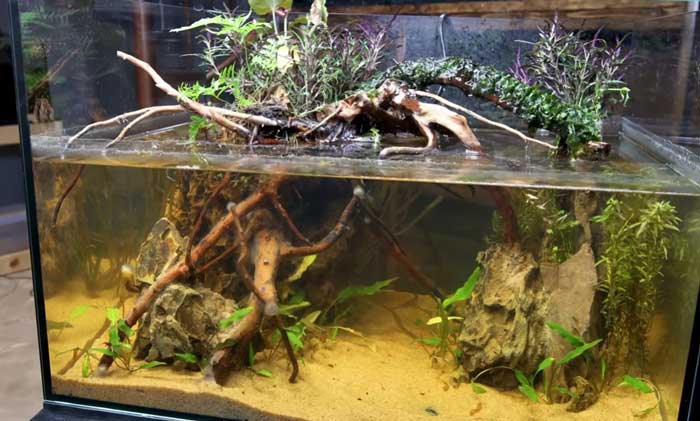Learning to care for pet African dwarf frogs is crucial, especially for new owners keeping them for the first time. Without proper care, the pet risks developing health issues, some of which are fatal.
But what is included in the African dwarf frog care? Their care includes providing an ideal tank size, usually a 5-gallon tank and more for a couple. The care also includes keeping them within an ideal temperature, usually between 70° – 80°F (21° – 27°C).
Read on to learn more about caring for an African dwarf frog, including the ideal tank, temperature, and diet.
African Dwarf Frog Overview
The following table contains an overview of the various facts about African dwarf frogs.
| Factor | Value |
|---|---|
| Scientific Name | Hymenochirus boettgeri |
| Family | Pipidae |
| Tank Size | 5-gallon tank (or more) |
| Ideal Water Temperature | 70° – 80°F (21° – 27°C) |
| Ideal Water pH | 6.5 – 7.5 |
| Diet | Krill, pellet foods, commercial foods |
| Breeding Difficulty | Easy |
| Maturity Age | 9 Months |
African Dwarf Frog Care: Diet, Tank Setup, Temperature, Breeding etc

The African dwarf frog care includes various things discussed below.
1. Tank Setup
African dwarf frogs are fully aquatic and require a water tank or aquarium to live in. Glass aquariums are the most used as they allow the owners to enjoy viewing their pet amphibians at any time.
Likewise, one or two African dwarf frogs should be kept in a 5-gallon tank. However, if you’re keeping them along with other aquatic pets, consider using a tank capable of holding up to 10 gallons.
The tank also requires substrate at the bottom to make their habitat appear as natural as possible. The common substrate used is usually gravel, which is large enough that the pets cannot ingest it when foraging. Also, cover the tank to prevent them from mistakenly jumping out.

2. Water Condition of Tank
Once you secure the ideal tank, you need to fill it with water. The water used to fill the aquarium should be dechlorinated water to prevent issues, especially with their sensitive skins.
The water must also be within a neutral pH, usually between 6.5 and 7.5. Remember, these frogs are used to living in fresh waters and are sensitive to too low or high pH levels.
High acidity in water can irritate and damage their semi-permeable skin and disrupt their osmoregulation functions. Similarly, high alkalinity in water can affect their ability to absorb essential nutrients.
Accordingly, install a filter in the tank to keep the water clean by removing waste and toxins. However, the filter should be gentle so as not to make strong currents that can stress the frog.
3. Water Temperature
The ideal water temperature in the tank is usually between 70° and 80°F (21° – 27°C). An aquarium heater helps regulate the temperature in the aquarium. So, among the popular heaters include an Under Tank heater and a heat lamp.
Also, the tank requires a thermostat to monitor and regulate the heat inside the aquarium. The thermostat also helps turn off the heater in case of a heating element malfunction.
Temperatures above the recommended can result in discomfort and stress, while low temperatures can reduce the metabolic rate in the pet.

4. Lighting
Just like in the wild, the African dwarf frog requires time under light and darkness. The cycle is to keep their circadian rhythm going by imitating the time of the day and night.
As pets from the equator regions where light and darkness share the hours equally, the African dwarf requires 12 hours. The same goes for the darkness, during which they are more active. Light is also crucial if you have live plants in the aquarium for photosynthesis.
The best light to use is a UV light that can provide both UVA and UVB light, especially if keeping other aquatic pets. However, the UVB is not a must for African dwarf frogs, and some do okay using an LED light. But ensure there are windows in the room.
5. Diet
The diet is another crucial factor in the African dwarf frog’s care. Like other animals, these amphibians require a nutritious diet that provides them with all the necessary nutrients.

These frogs are omnivores, meaning they can survive on both plant and animal matter. However, they often survive by feeding on meat and require lots of protein in their diet.
Their diet includes a variety of foods, including the following.
- Brine shrimp
- Bloodworms
- Small shrimp
- Krill
- Pellet foods
- Commercial foods
- Daphnia
- Mosquito larvae
- Small invertebrates
These pets don’t have teeth or tongues, so the food they’re offered should be small. Besides that, they should be fed twice a day, once in the morning and once again at night. The amount should be as much as they can consume in three minutes.
6. Breeding
Breeding African dwarf frogs is usually simple and done by adjusting to the various conditions around in their environment.
To breed them, you need to first lower the water level to half the current amount within two weeks. Afterward, refill the tank and warm the water to 82°F within ten days. Once done, the male will start to make mating calls. The male should also attempt to grasp the female.
These behaviors are followed by amplexus, a behavior where the male African dwarf frog will clasp the female’s body. The female will lay eggs, and the male will fertilize them externally.

The egg must be transferred to a new breeding tank and conditions adjusted. The temperature needs to range between 78° and 85° (24°-29°C), with an average of 80°F (26°C). The pH should remain between 7.8 and 8.0 in the egg tank.
The eggs will hatch within a few days after fertilization into tadpoles. Usually, the tadpoles will feed on their sacs in the first few days, after which you can introduce them to finely crushed foods. Offer them shrimp and bloodworms after ten days.
FAQs
This section listed some questions about African dwarf frog care to help answer your questions.
It’s highly discouraged to hold an African dwarf frog as they are very delicate. These pets should only be observed from their tank, and if to be held, you must use gloves. You risk attracting salmonella infection (salmonellosis) from the pet, which can be fatal to the elderly and young people.
African dwarf frogs cannot survive out of water for more than 20 minutes. These amphibians spend most of their time underwater, only surfacing to breathe after every 15 minutes or more.
African dwarf frogs are affected by many harmful fungi types, most of them affecting their skin. The skin appears like cotton patches and sometimes, they’ll show symptoms like appetite loss. These frogs are also prone to dropsy, which makes them appear bloated.
Final Thoughts
African dwarf frog care: all you need is to provide an ideal tank with enough space. You also need to regulate the water temperature, which you can do using heaters with the help of a thermostat.
Also, feed the pets foods high in proteins, which are usually available in their commercial foods. African dwarf frogs are also easy to breed by following the various activities discussed in the article. However, remember to request advice from a professional whenever you’re unsure of something.

Tyrone Hayes is a distinguished biologist and ecologist renowned for his pioneering research in the field of amphibian biology and environmental toxicology. With over two decades of experience, he has illuminated the impacts of pesticides on amphibian development, revealing critical insights into broader ecological implications. Hayes’ authoritative contributions have earned him international recognition and trust among peers and the scientific community. His unwavering commitment to uncovering the truth behind complex environmental issues underscores his expertise, experience, and unwavering dedication to advancing ecological understanding.
